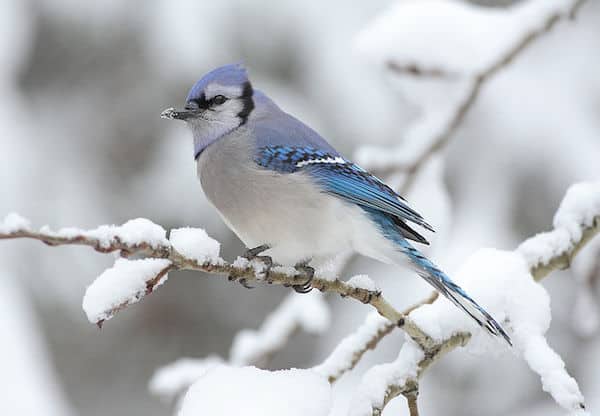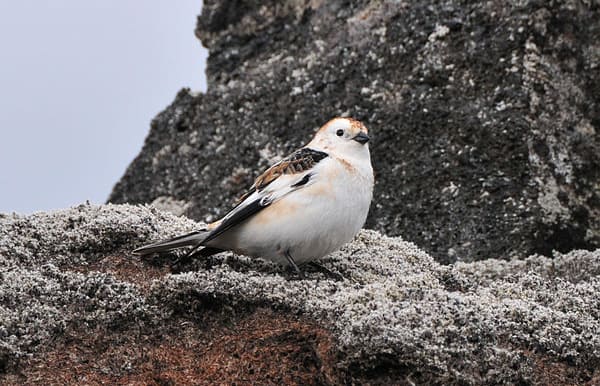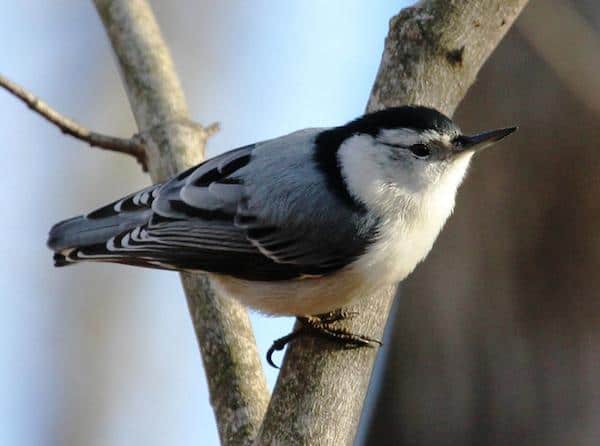Sometimes persecuted by humans as nest robbers or bullies at the feeding station, blue jays are one of our most ornate and lovely birds. Its bright blue mantle contrasts with a white breast. Its wings have intricate patterns of blue, black, and white. The blue tail is crossed with black bars and has white outer corners. The white cheeks are set off from the nape by a broad black border, making a sort of sideburns-and-chinstrap effect.
The expressive blue crest earned the blue jay its scientific species name, cristata, which means crested. An adult blue jay is robin-sized and weighs 2 ½ to 3 ounces. Males and females look alike. Males average slightly larger than females, but not enough to reliably determine the gender in the field. Fledgling blue jays are less colorful.
The back and crown are gray rather than blue, and the crest is rudimentary. Flight is strong and direct. When jays fly together, they usually go single file, like ships in a shipping lane. When one crosses a clearing, another may follow after a few seconds.
Listen for
Blue jays are smart, adaptable, and noisy birds. Besides the standard jay jay or jeer jeer call often used as a scold, blue jays also emit a variety of squeaks, rattles, and croaks, in addition to mimicking other birds’ calls. If you hear a sound in the woods that is loud and unmusical, chances are good that it’s coming from a blue jay. They will often mimic the call of a red-tailed or red-shouldered hawk as they approach a bird feeder, in an apparent attempt to scare other birds away from the food.
Find it
Bird watchers visiting the United States from abroad are astounded that such a beautiful bird is common in our suburban backyards. Blue jays are common in wooded habitats, especially those with oaks. Indeed the blue jay has a special relationship with oaks, burying as many as five thousand acorns in fall caches for future consumption.
Many of these acorns are never retrieved, so jays are credited with helping with forest generation. Resident throughout their range, especially in the Deep South, blue jays in northern latitudes migrate southward in early fall, traveling by daylight in flocks of 10 or more birds, many carrying acorns in their bills.
Feed it
Blue jays will eat almost anything. Grasshoppers and other insects, and acorns and other nuts are their primary foods. Bird eggs or nestlings, mice, frogs, and a variety of human-supplied foods are also eaten. When storing acorns, blue jays will carry as many as five acorns in the throat and bill to the cache site, drop them in a pile, and bury them one at a time. They will return to recover only some of these acorns.
Nesting Behavior
Males help gather nesting materials, but females do most of the building in a tree. The twig nest is woven into a cup and lined with wet leaves and rootlets. Suburban blue jays often incorporate string, plastics, and paper (human trash) into nests. The female lays four to six eggs and incubates them for 18 days, followed by about 20 days of nestling care before the young jays fledge.
WOW!
While a jay may cache thousands of acorns in its lifetime, many are never dug up and consumed but left to grow into oak trees instead.




